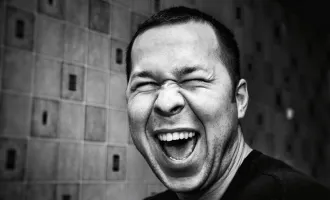
This Date in UCSF history: Haight-Ashbury Free Clinic Changes With the Times
Originally published in Synapse – The UCSF Student Newspaper on October 25, 1990. In early 1967, David Smith was embarking on a career in academic medicine as a postgraduate fellow in pharmacology and toxicology at UCSF. On his way to and from campus, however, the reality of what was going down that year in San Francisco changed his career and life.
“I’d spend the day in the lab, injecting white rats with LSD, mescaline, and amphetamines,” recalls Smith. “Then I’d walk home through the Haight and see kids who were taking those same drugs.
“The legal approach was to throw them in jail. I knew there was going to be a tremendous influx of flower children in the summer, and that it had the potential to be the most serious medical emergency since the 1906 earthquake and fire. Something had to be done.”
Smith decided he was the one to do it.
Along with a small group of people that included some of his colleagues and teachers at UCSF, he spent the early months of 1967 raising money and supplies and recruiting an all-volunteer staff for a medical clinic in the Haight.
The massive migration of young people into the Haight that summer seemed to prove Smith prophetic, but the array of health problems they brought with them made the steps he had taken all the more important.
Because of his foresight, the Haight-Ashbury Free Medical Clinic was able to open at the corner of Haight and Clayton Streets on June 7,1967, just as the “summer of love” got into full swing.
On that first day, the Clinic had a full load of patients, requesting help for just about every kind of medical problem imaginable and then some.
Smith and his colleagues hoped to at least keep the clinic open through that summer, and then see what happened.
But 23 years later, the same need for medical care remains, although the original single medical office has long since expanded into an extensive network of services and programs serving the entire city.
Change and growth
Over the intervening years, the Haight-Ashbury Free Medical Clinics (HAFMC) has grown and evolved in response to the health-care needs of the community.
Times have more often than not been lean, and the clinics even closed at a couple points in the early years.
As the hippies were replaced by heavier drug-using speed freaks and heroin addicts, the original mission of the HAFMC — to provide nonjudgmental care, free of charge to the patient — was tested over and over.
Through the 1970s and 1980s, successive waves of new kinds of substance abuse epidemics and then new epidemics of other origins — especially AIDS — have placed the HAFMC at the forefront of community-based healthcare not only in San Francisco but at the national level.
When epidemiologists on the streets, some of the first people they turn to are those who work at what is now the oldest such “free” clinic in the nation.
The HAFMC is now an 100-employee, 500-volunteer, $5 million organization, consisting of the original medical clinic and linked units providing alcoholism treatment, drug detoxification and rehabilitation, the women’s needs center, a residential drug and alcohol detoxification home for women, the “rock medicine” service for large musical events, and extensive research and education arms.
The Journal of Psychoactive Drugs has been published by the HAFMC since 1967 and is distributed worldwide.
Current emphases in many clinic activities are on incorporating the disease model of addiction into a comprehensive medical and social approach to treatment, focusing on the groups most at risk for substance abuse.
“Clinics like ours are becoming the ‘health maintenance organizations’ for treating addiction,” says Smith.
“We manage not only the primary addiction, but the whole scope of health problems, applying a public health model to communicable diseases.”
The clinics now provide 400 to 500 units of service per day, adding up to over 50,000 patients per year and totaling well over 1 million visits since opening day.
The HAFMC patient population has long since expanded beyond the Haight-Ashbury.
Today, Smith reports that over 60 percent of the patients are nonwhite, whereas the original hippies were mostly white and middle class.
“We’re currently seeing an upsurge in heroin use, which is somewhat predictable following a surge in stimulant abuse,” reports Smith, referring to the crack cocaine epidemic of recent years.
“In order to address this, in recent years we’ve branched out with more joint projects in the African-American community, including with Cecil Williams at Glide Memorial Church and in the prisons. In those communities as well as in the Haight, HIV is increasingly a problem we encounter as well. We’ve-also expanded into the East Bay, and work with the homeless, especially homeless alcoholic women.”
Strong links to UCSF
The HAFMC’s roots and continued strong linkage with UCSF continues to this day and has proven invaluable to the clinics’ survival many times, says Smith, who is an Associate Clinical Professor of Toxicology here.
“The concept of the clinic was essentially born in the UCSF department of pharmacology, and the support and volunteer time of UCSF faculty and students has helped keep us going ever since,” he says.
“Most recently, UCSF extended our use of the Laurel Heights building, which they offered to us after the big September 1988 Haight fire burned us out of much of our administrative space,” he notes.
Smith says the burnt building is now ready for occupancy again, but zoning issues are delaying the HAFMC’s return there.
In addition, hundreds of UCSF students and residents have done official and unofficial stints as trainees and volunteers at various HAFMC units, and clinic staff teach about chemical dependency issues on campus.
From radicals to “good old boys”
The founding principles of the HAFMC remain that health care is a right, not a privilege, and that it should be free at the point of delivery for all who need it.
Further guiding clinic philosophy holds that healthcare should be demystified, non-judgmental, and humane, with an emphasis on preventive medicine and with patients having a choice between alternative methods of treatment whenever possible.
“Our philosophical positions on the right to health care and on addiction as a treatable disease are becoming more and more accepted around the world,” says Smith, who now travels widely giving lectures but has made a commitment to living and working in the Haight for the rest of his life.
Smith is very aware of some of the ironies the HAFMC’s successes present.
“Starting this clinic in 1967 was perceived as a radical act,” he reflects.
“Treatment of addicts and drug abuse, especially for free, was just not done. Well, now substance abuse treatment is an industry, with everyone vying for resources.
“Even though we’ve always struggled to keep going, now some people perceive us as part of the established ‘good old boy’ network.
“In some ways this helps, as when it comes time to cut health budgets — we’re working in relatively high priority areas and have been around a long time. But who would have guessed it back then?”



